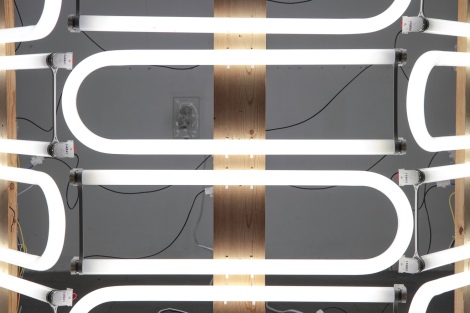U-Bend Pillar
Meagan Streader
Friday, 20th January – 4th February 2017
Essay by Brigid Hansen
Cool white light emanates in a triangulation from the centre of the gallery, bleeding into the corridor and onto the black concrete floor. A hexagonal three-tiered timber structure has been custom-built to nuances of Nicholas Projects’ interior (see: large structural beam) and sits in the centre of the gallery. 28 U-shaped fluorescent tubes are fixed to the exterior of the structure, artist Meagan Streader working from the ground up; piece by piece removing the clean, white bases from each fluorescent tube light before fixing them at equal distances until they reach the ceiling. Bundles of primary-coloured wires protrude from their ballasts, and as the electrical component develops, they morph from a tidy bunch to an organic, theatrical network of wires equally as useful as they are dramatic.
Streader presents to viewers a structure comprised of binary paradigms; order and chaos, conductor and insulator, colour and monochrome, a tableaux that is cinematic yet clinical, a structure that is supported, but not fixed. These contradictory forces are cemented by the sculptural installation’s emphasis on the exterior/interior, creating a kind of segmentation of spaces relative to the structure’s fluorescent outer, the mechanical innards and the surrounding emptiness of the gallery.
Until ‘U-Bend Pillar’, Streader hadn’t worked with fluorescence since 2014, but rekindled her interest in 2016 during a residency with NARS Foundation in New York in 2016 where she came across long U-shaped fluorescent tubes at a hardware store, designs that are unavailable in Australia. This lead to experimentation with constructing new shapes and forms using fluorescent as the primary framework and consolidating these imagined structures with a physical support frame. In ‘U-Bend Pillar’, Streader extends a prior work developed during her residency titled ‘One-Quarter U-Bend Column’, choosing to paint the supporting structure a cool white to conceal it against the white-cube of the gallery and emphasise the dominance of the fluorescent tubes.

One-Quarter U-Bend Column, 2016. Meagan Streader
During a studio visit, the artist and I discuss the issue of accessibility in art and her particular interest in light as material, in particular the way that various kinds of light have the capability of altering one’s perception and impression of space. Indeed, sensory stimulation is a core aspect of this work, both the light and heat of the unventilated space and the slight warmth emanated from the installation affect the viewer immediately as they enter the space. The use of white light and the choice of proximity between each fluorescent tube is highly considered and adjusted intermittently during installation. High-lumen level fluorescents are the one constant in the artist’s work, in which the flexibility and curvature of form is explored through weaving, bending and optical play with fluorescent tubing or electroluminescent wire. Streader believes that a white light – light in its purest form – is more synthetic and stark, lending itself to an exploration of these ideas without nostalgic or domestic associations coming to mind.
Streader’s post-minimalist ‘U-Bend Pillar’, with its exposed wiring and visible clamps, favours both a geometric, simplified approach to design and a visible manifestation of the artist’s hand. Manic nodes and networks of thin red, blue and yellow wire culminate at a central peak inside the equilateral beacon of light. Given the highly spatial, mathematical nature of her designs, it is fitting that she shares her studio with not artists but a set designer and an industrial designer. Streader denounces the process fetishism bred into contemporary practice by educational institutions, instead focusing entirely on the final object, the focus being to give more attention to the existing space into which it will fit and subsequently altering the structure in response. The designs of her sculptural installations are sketched out many times prior to their construction, both on grid paper and rendered digitally. ‘U-Bend Pillar’ divulges from Streader’s prior emphasis on concealing the technical aspects of her work, highlighting the importance of the assemblage process and its display, particularly as a woman artist working with materials used frequently in the male-dominated sphere of construction.
Streader has created an accessible void that provokes a highly metaphysical response. ‘U Bend Pillar’ becomes almost a test of endurance given the strength of its light and its dispersed impact across the entire gallery. A readjustment of the gaze occurs as soon as one is struck by the impact of 28 white curved fluorescent tubes and there is a striking immediacy to this sensation. ‘U Bend Pillar’ takes advantage of the small space, its central placement both drawing one in and prompting one to consider three points beyond the structure illuminated by its light. We are provoked to consider the relationships between space and structural intervention, and how this affects movement, perception and our own physical response.
Brigid Hansen is a Melbourne-based freelance arts writer currently completing her Master of Arts (Arts Management). She interns at Blindside, works at The Melba and has interests including: Kylie Minogue, kebabs, big hair and art. You can contact her at brigidhansen@hotmail.com This essay was produced in partnership with CRITICAL, RMIT Link Arts & Culture’s Arts Writing Program. If you are interested in writing for Nicholas Projects, email katielouisepaine@gmail.com
